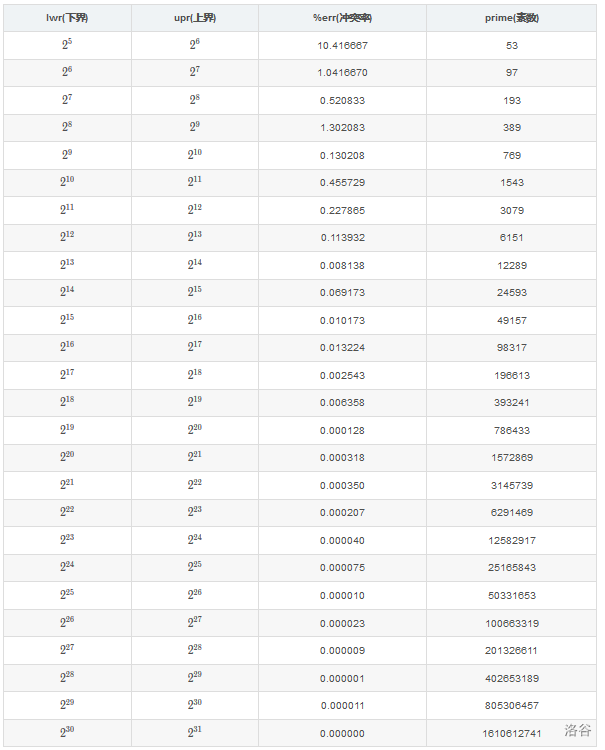标签:字符 signed 选择 image 记录 name 元组 sys code
给定一个字符串 \(s=s_1,s_2,s_3 ... s_n\) ,
对字母\(x\),我们规定 \(idx(x)=x?′a′+1\)。
(当然也可以直接用 \(s_i\)的 ASCII值)
利用 \(ull\) 的自然溢出,对其取模
\(hash\)公式:
\(p\) 和 \(mod\) 均为质数,且 \(p<mod\) (尽量取大)
假设 \(s=abc,p=13,mod =101\)
hash[0]=1;
hash[1]=(hash[0]*13+2)%101=15;
hash[2]=(hash[1]*13+3)%101=97;
\(abc=97\) , \(97\) 即为 \(abc\) 哈希值;
将一个字符串用不同数值的 \(mod\) \(hash\) 两次,将这两个结果用一个二元组表示,作为 \(Hash\) 结果。
\(Hash\) 公式
用\(map\)存储结果为 \(<hash1[n],hash2[n]>\)
这种\(hash\)很安全。
若已知一个 \(|s|=n\) 的字符串的 \(hash\) 值,\(hash[i],1≤i≤n\) 。
其子串
\([S_l..S_r],1≤l≤r≤n\) 对应的 \(hash=f(r-l)\) 值为:
考虑到 \(hash[i]\) 每次对 \(p\) 取模,进一步得到下面的式子:
括号里面是减法,即有可能是负数,故做如下的修正:
至此得到求子串 \(hash\) 值公式。
我们可以预先求出来 \(p^{\sum^n_1}\) 的各项值,直接求解即可。

给定几个字符串,按顺序求对于他们的最小表达,例如 want to ,最小表达为 wanto
看到这个题,我们可以快速得出来一个解决方法,比较前字符串的后缀和后字符串的前缀,如果相同,则不将后字符串的相同部分进入答案,如果不同,那么就加进去答案。
用双 \(hash\) 处理,对于答案序列设 \(h1[n],h2[n]\) ,当前序列为 \(hash1,hash2\)
那么此时序列成立的条件是:
如果成立,就把当前的i进行记录 \(L=i\)
向答案序列中加入的就是序列 \(s[L-len]\)。
代码:
#include<bits/stdc++.h>
using namespace std;
#define ll long long
const int N=1e6+6,mod1=19260817,mod2=19491001;
ll p1,p2;
int n,cnt=0;
ll P1[N],P2[N],h1[N],h2[N];
char s[N],ans[N];
void init(){
srand(time(0));
p1=rand()%321+233,p2=rand()%233+321;
P1[0]=P2[0]=1;
for(int i=1;i<=N-6;i++) P1[i]=(ll)P1[i-1]*p1%mod1,P2[i]=(ll)P2[i-1]*p2%mod2;//cout<<P1[i]<<" ";
}
signed main()
{
cin>>n;
init();
for(int T=1;T<=n;T++){
scanf("%s",s+1);
int len=strlen(s+1);
int hash1=0,hash2=0,L=0;
for(int i=1;i<=len&&i<=cnt;i++){
hash1=((ll)hash1*p1+s[i])%mod1;
hash2=((ll)hash2*p2+s[i])%mod2;
if(h1[cnt]==(hash1+(ll)h1[cnt-i]*P1[i])%mod1&&
h2[cnt]==(hash2+(ll)h2[cnt-i]*P2[i])%mod2)
L=i;
}
for(ll i=L+1;i<=len;i++){
ans[++cnt]=s[i];
h1[cnt]=((ll)h1[cnt-1]*p1+s[i])%mod1;
h2[cnt]=((ll)h2[cnt-1]*p2+s[i])%mod2;
}
}
printf("%s",ans+1);
//system("pause");
return 0;
}
标签:字符 signed 选择 image 记录 name 元组 sys code
原文地址:https://www.cnblogs.com/guanlexiangfan/p/14905041.html